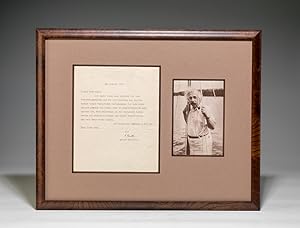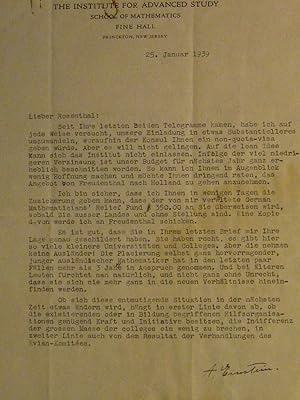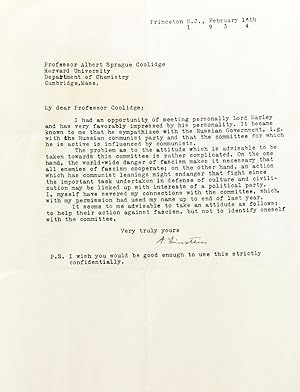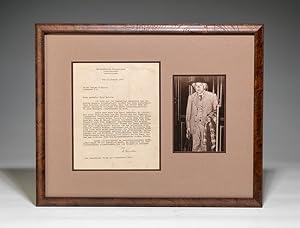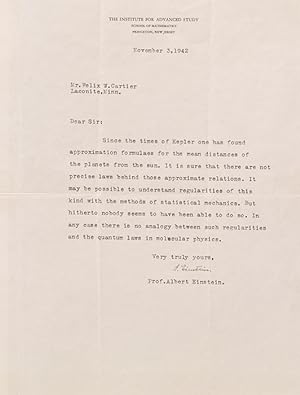Typed Letter by Albert Einstein: Books (5 results)
Product Type Clear
- All Product Types
- Books (5)
- Magazines & Periodicals
- Comics
- Sheet Music
- Art, Prints & Posters
- Photographs
- Maps
-
Manuscripts &
Paper Collectibles (35)
Condition
- All Conditions
- New
- Used
Binding
- All Bindings
- Hardcover
- Softcover
Collectible Attributes
- First Edition (1)
- Signed
- Dust Jacket
- Seller-Supplied Images
- Not Printed On Demand
Seller Location
Seller Rating
-
Typed letter signed
Publication Date: 1946
Seller: Bauman Rare Books, Philadelphia, PA, U.S.A.
Signed
"EINSTEIN, Albert. Typed letter signed. Princeton, April 3, 1946. Single sheet of gray letterhead, measuring 8-1/2 by 11 inches; p. 1. Matted and framed with a portrait, entire piece measures 19 by 15-1/2 inches. $9500.Original typed letter signed by Albert Einstein, thanking his friend, Dr. Isadore Held, for his birthday wishes as well as for sending a new book that Einstein found both "extraordinarily enlightening" and humorous. Text in German.The letter, typed on Einstein's personal letterhead with his name and Princeton address blindstamped at the top, reads in full translation: "3 April 1946. Dear Mr. Held: I would like to express my sincere thanks for your birthday wishes and for the sending of the last work of this wonderful contemporary. I have already read quite a bit and find that it is extraordinarily enlightening. His penetration into the mentality of far-off times and attitudes toward thinking is most remarkable and his humor no less. With fond greetings to you and your dear wife. Yours [signed] Albert Einstein." This letter was written to Austrian-American (medical) Dr. Isadore Held, who was friends with Einstein since at least 1938. Held and Einstein shared numerous interests, particularly related to Jewish humanitarian relief and Israel. At Held's death, Einstein wrote to his widow that, "True goodness emanated from this man, who alleviated the harshness of human relations and who understood and forgave all weaknesses As a role model for his fellow men he was the best that a human being can be." Einstein was not a huge fan of birthdays, though he happily acknowledged well wishes from friends. Just before turning 65, Einstein crankily said to a New York Times interviewer: "What is there to celebrate? Birthdays are automatic things. Anyway, birthdays are for children." In a 1954 letter to physicist Hans Mühsam, Einstein described his birthday as "a natural disaster, a shower of paper, full of flattery, under which one is drowned." Einstein was generally quite shy and did not like to be the center of attention, particularly from strangers obsessed with his accomplishments and fame. However, well-meaning letters and small gifts like the book given by Held were always welcomed and graciously accepted by Einstein. Original mailing creases and a few pinpoint holes along top edge possibly from stapling. About-fine condition.". Signed.
-
Einstein Typed Letter Signed "A. Einstein." written on his professional letterhead: "The Institute for Advanced Study, School of Mathematics, Fine Hall, Princeton, New Jersey. Einstein laments the opportunities for foreign and older students to enroll or teach at the smaller colleges in the United States: "It is good that in your last letter you described your situation to me. You're right, there are so many smaller universities and colleges here. But they do not take foreigners! The placement of even outstanding young foreign mathematicians has taken more than 3 years in the last few attempts. And older people, of course, and they are not unjustified, are afraid that they will never quite find their way into the new circumstances."
Published by 25. January 1939, 1939
Seller: Brainerd Phillipson Rare Books, Holliston, MA, U.S.A.
Association Member: SNEAB
Signed
No Binding. Condition: Very Good. No Jacket. Einstein letter of approx. 250 words, typed in German, dated 25. Januray 1939 and signed in ink by "A. Einstein." With a few single letter corrections in Einstein's hand. The letter is in very good condition, typed on Watermarked paper," Chieftan Bond" with high rag content. With two rust marks at the top edges from the removal of old paperclips. Light staining to the bottom right-hand side, barely perceptible, like faded tea stain. Strong at the folds. Lieber Rosenthal: Seit Ihre letzten beiden Telegramme kamen, habe ich auf jede Weise versucht, unsere Einladung in etwas Substantiellerea umzuwandeln, weraufhin der Konsul ihnen ein non-quote-visa geben wurde. Aber es will nicht gelingen. Auf die loan Idee Kann sich das Institut nicht einlassen. Infolge der viel niedrigeren Verzinsung ist unser Budget fur nachstes Jahr ganz erheblich beschnitten worden. So kann ich Ihnen im Augenblick wenig Hoffnung machen und mochet Ihnen dringend raten, das Angebot von Freudenthal nach Holland zu gehen anzunehmen.Ich bin sicher, dass ich Ihnen in wenigen Tagen die Zusicherung geben kann, dass der von mir verwaltete German Mathematicians Relief Fund $350.00 an Sie uberweisen wird, sobald Sie ausser Landes und ohne Stellung sind. Eine Kopie davon werde ich an Freudenthal schicken. Es ist gut, dass Sie in Ihrem letzten Brief mir Ihre Lage genau geschildert haben. Sie hben recht, es gibt hier so viele kleinere Universitaten und Colleges. Aber die nehmen keine Auslander! Die Placierung selbst ganz hervorragender, junger auslandischer Mathematiker hat in den letzten paar Fallen mehr als 3 Jahre in Anspruch genommen. Und Bei alteren Leuten furchtet man naturlich, und nicht ganz ohne Unrecht, dass sie sich nie mehr ganz in die neuen Verhaltnisse hineinfinden werden. Ob sich diese entmutigende Situation in der nachsten zeit etwas andern wird, hangt in erster Linie davon ab, ob die existierenden oder in Bildung begriffenen Hilfsorganisader grossen Masse der colleges ein wenig zu brechen, in zweiter Linie auch von dem Resultat dr Verhandlungen des Evian-Komitées. "A. Einstein" Translation via Google Translator:Dear Rosenthal: 25. January 1939Since your last two telegrams came, I have tried in every way to turn our invitation into something substantial, after which the Consul gave them a non-quota visa. But it has not succeeded. On the loan idea the institute can not get involved. As a result of much lower interest rates, our budget for next year has been curtailed considerably. So I can not give you much hope at the moment and I urge you to accept the offer of Freudenthal to go to Holland.I am sure that in a few days I can assure you that the German Mathematicians' Relief Fund I manage will transfer $ 350.00 to you as soon as you leave the country and are out of a position. I will send a copy of it to Freudenthal.It is good that in your last letter you described your situation to me. You're right, there are so many smaller universities and colleges here. But they do not take foreigners! The placement of even outstanding young foreign mathematicians has taken more than 3 years in the last few cases. As for older people, of course, and they are not unjustified, they are afraid that they will never quite find their way into new circumstances.Whether this discouraging situation will change somewhat in the near future depends primarily on whether the existing or developing aid organizations can offer substantial support to the colleges, and secondarily on the outcome of the negotiations of the Evian-Komitées , "A. Einstein."Albert Einstein (1879 1955) was a German-born theoretical physicist. Einstein developed the theory of relativity, one of the two pillars of modern physics (alongside quantum mechanics). Einstein's work is also known for its influence on the philosophy of science. Einstein is best known by the general public for his mass energy equivalence formula E = mc2 (which has been dubbed "the world's most famous equation"). He received the 1921 No. Signed by Author(s).
-
Typed Letter Signed
Published by np, Princeton, 1934
Seller: Manhattan Rare Book Company, ABAA, ILAB, New York, NY, U.S.A.
First Edition Signed
No Binding. Condition: Very Good. 1st Edition. AN IMPORTANT SIGNED LETTER (in English) by Einstein, revealing his reservations of associating with communism even in the fight against fascism. Written from Princeton, NJ, to Professor Albert Sprague Coolidge of Harvard University, and dated February 16, 1934, the letter reads: My dear Professor Coolidge: I had an opportunity of meeting personally Lord Marley and has [sic] very favorably impressed by his personality. It became known to me that he sympathizes with the Russian Government, i.g. with the Russian communist party and that the committee for which he is active is influenced by communists. The problem as to the attitude which is advisable to be taken towards this committee is rather complicated. On the one hand, the world-wide danger of fascism makes it necessary that all enemies of fascism cooperate; on the other hand, an action which has communist leanings might endanger that fight since the important task undertaken in defense of culture and civilization may be linked up with interests of a political party. I, myself have severed my connections with the committee, which, with my permission had used my name up to the end of last year. It seems to me advisable to take an attitude as follows: to help their action against fascism, but not to identify oneself with the committee. Very truly yours, [signed] A. Einstein P.S. I wish you would be good enough to use this strictly confidentially. In 1934, Lord (Baron) Marley (Dudley Leigh Aman), toured the United States to raise funds for his association, the World Committee for the Victims of German Fascism. Marley, through his committee, was "passionately advocating a scheme for which he was to become an international figurehead - resettlement of oppressed German and Polish Jews in the Jewish Autonomous Region" in Siberia. He published a book, "The Brown Book of the Hitler Terror and the Burning of the Reichstag, sponsored by the World Committee and with an Introduction written by Lord Marley himself, [which] was the first popular exposé of what was happening in Hitler's Germany. It documented the destruction of political parties, trade unions and universities, book-burning, and the building of concentration camps. "At a fundraising dinner held in his honour in New York in February 1934 [where Einstein presumably met him, just before writing this letter], Marley opened the Brown Book and 'speaking quietly, declaring that he did not intend to harrow', read aloud to his audience of 600 American Jews some of the collected evidence of Nazi repressions. Here were documentary records of what was happening in Germany - a substantiation of the brutality that hitherto had had no distinct form in the mind of the American Jewish public. What before had been the subject of a growing fear mingled with disbelief was now being presented as hard fact and supported with detailed evidence. The New York Times (8 February 2005) reports the audience being 'startled' by the disclosures, and the night ending with $3,500 raised for the World Committee" (The Jewish Quarterly, No. 198). Einstein was correct to be suspicious of Marley's activities, for it was later determined that the "World Committee" was indeed a Communist front; Einstein, writing here to Coolidge in 1934, was prescient about the motives of the committee. This letter, in addition to underscoring Einstein's passionate stance against fascism, is particularly important as documentary evidence of Einstein's caution about having any dealings with communism, especially considering that the U.S. FBI, worried about Einstein's political leanings, kept a file on Einstein that grew to 1427 pages. Princeton, NJ: February 16, 1934. One (8.5 x 11 in.) page. Envelope folds, minor spotting. An outstanding letter with important and revealing content.
-
Typed letter signed
Publication Date: 1942
Seller: Bauman Rare Books, Philadelphia, PA, U.S.A.
Signed
EINSTEIN, Albert. Typed letter signed. Princeton, New Jersey, January 13, 1942. One leaf of Institute for Advanced Study letterhead, measuring 8-1/2 by 11 inches, typing on recto only. Matted and framed with a portrait, entire piece measures 19 by 15-1/2 inches. $19,000.Wonderful typed letter signed by Einstein discussing planetary motion and the "fundamental laws of nature."The letter, written in German on letterhead from the Institute for Advanced Study at Princeton, is dated January 13, 1942 and addressed Vaclav V. Kalcik of Crompond, NY. It reads in translation in its entirety: "Dear Mr. Kalcik, I have looked at your manuscript and admired the extraordinary energy with which you have pursued your peculiar thoughts. Because I am overwhelmed with work, I cannot assure [you] to thoroughly follow your line of thought. But I have one thing to mention to you: It does not seem possible to me that anything fundamental about the laws of nature can be inferred from the planetary constellation. Imagine a shell shot vertically upward from one location at a velocity of about 20 km per second. Such a body would orbit the sun as an independent planet, and its trajectory could have been arbitrarily directed by us. In principle, it is possible (although not practical) to change the orbit elements arbitrarily by analogous methods. Thus, it seems to me that I can say with certainty that, for these orbit elements, no fundamental laws could be applied, out of which conclusions can be drawn about the fundamental laws. The heavy workload does not make it possible for me to follow your line of thoughts in more detail. Please, accept my apology for that. Sincerely your, [signed] A. Einstein. Your manuscript will follow by a separate mail."In response to the content of his correspondent's manuscript, Einstein here dismisses the argument by analogizing a planet to a shell shot out of a cannon. Since such a projectile can be directed as one wishes, Einstein argues that it is possible to affect the orbit of the planets through similar "arbitrary actions"; therefore "there can be no principal law from which one could draw conclusions about the elementary laws [of planetary objects]." The argument that the distribution of the planets in our solar system is the result of the working of a higher intelligence goes back at least as far as Plato, and was perhaps most famously argued in the modern era by Kepler. Einstein's argument here suggests that he saw the present order of the solar system more as a matter of chance, rather than a product of divine design. Expected fold lines, one marginal tear neatly repaired on the verso, not affecting text. Signed.
-
Typed letter signed
Publication Date: 1942
Seller: Bauman Rare Books, Philadelphia, PA, U.S.A.
Signed
EINSTEIN, Albert. Typed letter signed. Princeton, November 3, 1942. One sheet, measuring 8-1/2 by 11 inches, typing on recto only. $38,000.An exceptional typed letter signed by Einstein on precursors like Johannes Kepler's work to his Special and General Theories of Relativity,The letter, on letterhead from the Institute for Advanced Study in Princeton, reads in full: "November 3, 1942. Mr. Felix W. Cartier. Laconite, Minn. Dear Sir: Since the times of Kepler one has found approximation formulaes for the mean distances of the planets from the sun. It is sure that there are not precise laws behind those approximate relations. It may be possible to understand the irregularities of this kind with the methods of statistical mechanics. But hitherto nobody seems to have been able to do so. In any case there is no analogy between such regularities and the quantum laws in molecular physics. Very truly yours, [signed] A. Einstein. Prof. Albert Einstein."Early in the 17th century, Johannes Kepler (1571-1630) discovered that planets orbit the sun in ellipses rather than perfect circles. This great discovery paved the way for Isaac Newton's laws of gravity, and for Albert Einstein's general and special theories of relativity. Previous to Einstein's time, people believed in real distances and absolute time, and showed that instruments could not objectively measure the distances between planets. Einstein's theories, which hypothesized that light and space curve near a massive object, revolutionized scientific thought and gave man an exciting new perspective of his universe.Einstein's letter reflects on some of the most important scientific revelations in the history of physics and astronomy. Kepler defined three laws of planetary motion; however, the one specifically referred to in this letter is that all planets move about the Sun in elliptical orbits, having the Sun as one of the foci. If the Universe then consisted only of two point masses the Sun and a planet the orbit of that planet would make a perfect, closed ellipse that returned the world to its starting location with each trip around the Sun. But in a Universe governed by Newtonian gravity, with a plethora of massive bodies in our Solar System, that ellipse will precess, or rotate slightly in its orbit.In the mid-1800s, orbital deviations of Uranus from its predicted motions led to the discovery of Neptune, as the outermost world's gravitational influence accounted for the excess motion. But in the inner Solar System, the nearest planet to the Sun, Mercury, was experiencing a similar problem. With detailed, accurate observations going back to the late 1500s, thanks to astronomer Tycho Brahe, we could measure how Mercury's perihelion, its closest orbital point to the Sun, was advancing. The number we came up with was 5,600" per century, just over 1.5 degrees over a 100 year period. But of that, 5,025" came from the precession of Earth's equinoxes, a well-known phenomenon, while 532" was due to Newtonian gravity.But 5,025" plus 532" comes up short by a small but significant amount. Attempts at explanation including the existence of an unknown inner planet, interior to Mercury all failed. But after Einstein's special theory of relativity came out in 1905, mathematician Henri Poincare showed that the phenomena of length contraction and time dilation contributed a fraction, between 15-25%, of the needed amount towards the solution, dependent on the error. That, plus Minkowski's formalization of space and time as not separate entities, but as a single structure bound together by their union, spacetime, led Einstein to develop the general theory of relativity. On November 25, 1915, he presented his results, computing the spectacular figure that the contribution of the extra curvature of space predicted an additional precession of 43" per century, exactly the right figure needed to explain this observation, sending shockwaves through the astronomy and physics communities. Less than two months after this, Karl Schwarzschild found an exact solution, predicting the existence of black holes. The deflection of starlight and gravitational redshifts/blueshifts were realized as possible tests, and finally the solar eclipse of 1919 validated general relativity as superseding Newtonian gravity. Expected fold lines. An incredible letter, scarce in its important content. Signed.


